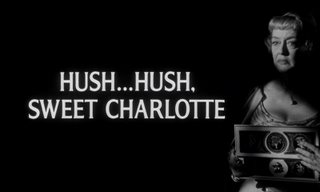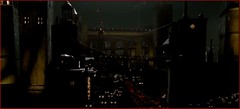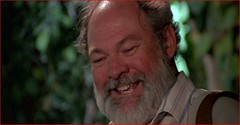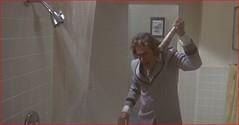
DVD Panache is proud to be a part of Dennis Cozzalio's Robert Aldrich Blog-a-Thon today. Dennis organized this nice event, and his blog Sergio Leone and the Infield Fly Rule serves as the launching point for several other blogs contributing Aldrich-themed blogs (I particularly enjoyed Andy Horbal's take on The Dirty Dozen and the Last Supper). Since it is Horror Month here at DVD Panache, I chose to take a look at perhaps my favorite opening sequence of any horror movie -- Aldrich's Hush . . . Hush, Sweet Charlotte. In 15 minutes we get giant chunks of the plot, unforgettable shots and a pace and sense of dread that the movie really never reaches again after the credits roll.
------------------------
'Sweet Charlotte' is Aldrich's unofficial follow-up to his timeless What Ever Happened to Baby Jane?. Both films deal with simmering family tension and jealousy, and with Joan Crawford and Bette Davis lighting up the screen in 'Baby Jane,' it was planned for them to reprise their co-billing, but it was not to be (Crawford's role was offered to several other prominent actresses, as explained in greater detail here). Olivia de Havilland eventually accepted the role and her quiet, repressed demeanor was a perfect contrast to Davis' searing expressions. Besides themes and cast members, 'Baby Jane' and 'Sweet Charlotte' also share highly memorable opening sequences. In 'Baby Jane,' Aldrich gives us a brief but effective expository flashback to the good times, before flashing forward to the troublesome present and giving us the title card. The long delay of the opening credits would be seen in other Aldrich movies (such as 'The Dirty Dozen,' where it was used to great effect). Aldrich no doubt saw that using a prologue such as this before the credits could be used to take his audience off guard and draw their attention even more, and he ratcheted up this technique to the highest possible level in 'Sweet Charlotte,' where we are given a variety of scenes, tones and imagery before we are told what movie we are watching.
Aldrich opens the film with a series of stationary shots of a striking Louisiana mansion during the prohibition era. Each shot shows a different angle of the house and gradually draws closer, until the faint talk we heard in the first couple shots becomes Victor Buono's bellowing Big Sam Hollis. The terse exchanges between Big Sam and John Mayhew (a young Bruce Dern) gives us plot tidbits from characters whose only screen time is in this opening prologue. John is married to Jewel, but plans on eloping with Big Sam's daughter Charlotte at an upcoming party, until Big Sam tells him to do otherwise. Key foreshadowing in this scene includes John defending himself with a chair as Big Sam approaches him and a painting of Big Sam seemingly looking down on John. The next sequence is set up perfectly as Big Sam begins to tell John what his instructions are for the following night's party.
The party sequence is where the prologue literally starts dripping with Aldrich's craftsmanship. We are led into the stately event and hear our first nugget of pulp dialogue: 'Have you seen Charlotte? I've got some killing news to tell her.' I had always heard this line as 'killer news,' but the subtitles say otherwise and it just adds to the subtle camp horror nature of the party scenes. As the inquisitive guest leaves to find Charlotte, she runs into a nervous Big Sam, who mutters something to himself before exiting quickly -- leading the camera to a waiter carrying an ice bucket with a bottle of champagne in it, which Aldrich's lens follows through the room (more foreshadowing, as we will soon find out), before holding on a Hollis family portrait.
We then find John telling Charlotte the news: he's dropping the plans to elope, but insists that he 'really loved her at one time.' As we see Charlotte sobbing (her face hidden, as it will be for the entire scene) and John trying to console her, the camera slowly pans left, leading to a shot of the two characters through the bars of a bird cage. Inconsolable, Charlotte storms off and yells 'I could KILL YOU!' Aldrich is not hiding the fact that someone (most likely John) is going to be killed before the party, and the looming dread is further enhanced by an overly long shot of a butcher knife used by a waiter to open a champagne case -- and a later look showing us that someone has swiped it. These shots are interspersed with looks at the still nervous Big Sam pacing outside, perhaps contemplating -- a murder?
We then find John toying with Charlotte's bouquet she threw at him in the previous scene, apparently waiting for his jilted lover to return and practicing what he will say to her. The door slowly opens and an unseen figure enters, John expects to see Charlotte, but all we see is that butcher knife wailing away on John -- cutting off his hand (still clutching the bouquet) in a shocking vision of gore (his stump of an arm now resembling that champagne bottle the camera focused on earlier). The knife continues to fall on John, and his screams and blood fill the room (with the encaged birds being the only real witnesses). This violent scene sets up the film's signature moment:
As the band plays one last number ('Goodbye Ladies'), we finally get our first look at Charlotte: bathed in shadows save for horror-filled eyes, she is set against the backdrop of the lively party until that inquisitive guest with the 'killing news' finally spots her. 'Oh there's Charlotte!' silences the band and the rest of the room as they turn to see Charlotte with her back turned. As our title character turns around we see her white dress has a large blotch of blood around the waist -- evoking all kinds of murderous coming-of-age metaphors. Gasps are the only words uttered before Big Sam spies his daughter and slowly approaches her: 'Come with me baby,' 'I don't want to, Papa.' The shot of Big Sam holding out his hand fades to black, leaving us Aldrich's finale of the prologue.
We are shown the house again, but it is now 1964. A group of boys approach the decaying mansion and dare one of their members to go inside, their minds on the legend of Charlotte Willis murdering her lover with a butcher knife. The terrified boy enters the silent house -- his nerves set ablaze by the chimes of a grandfather clock -- and spies a nearby music box. He goes around a large armchair and picks it up, before being scared nearly to death by a startled Charlotte who had been sleeping in the chair. Charlotte seems dazed, and the screaming boy escapes out a nearby door. Holding the open music box, Charlotte approaches the open door and calls out for John. The boys laugh and run off and we hear that the mystery of Charlotte has now become a youthful chant: 'Chop, chop sweet Charlotte/Chop chop till he's dead . . . ' The confused Charlotte takes up a quarter of the screen, as the opening credits fill the darkness surrounding her, leading to the above title card at the 15-minute mark.
This 15 minute prologue remains startling, becoming one of those opening moments that locks you into a film. Throughout the prologue, Aldrich displayed a number of economic techniques of exposition, giving the audiences a great deal of character background and plot points without using much dialogue at all -- while at the same time setting the perfect macabre mood which will permeate the rest of the running time.
Friday, October 13, 2006
HORROR MONTH: 15 'Sweet' minutes
Filed Under Blog-a-thon, Essays, Horror Month
Subscribe to:
Post Comments (Atom)












No comments:
Post a Comment